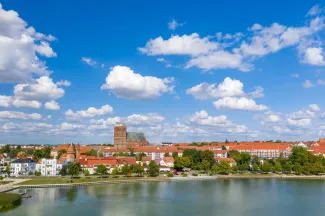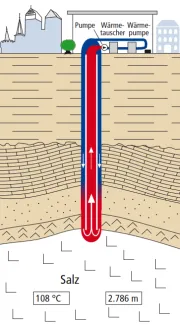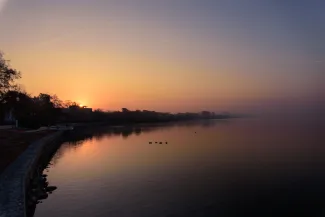
Prenzlau, Germany
Deep in Germany, not far from the Polish border, lies Prenzlau: a town of some 18,000 inhabitants. Its location in the middle of an underground heat basin that stretches across Poland, Denmark, Germany, the Netherlands and Belgium means the conditions here are good for exploring the potential of geothermal energy. And they did.
In the beginning
Back in the 1980s, people in the then GDR began an exploratory phase towards geothermal energy. Test drillings were carried out in the Prenzlau area and found favourable conditions to proceed with a practical application. Indeed, in Prenzlau the depth temperature rises by 10°C per 1000m more than elsewhere: for every km drilled in depth, the temperature rises by 40°C.
In 1994, the vertical heat probe at Thomas-Müntzer-Platz was commissioned.


30 years of uninterrupted renewable energy
In 1994, as part of a geothermal pilot project, an old power plant was converted into a geothermal one.
A borehole was drilled 2,786m deep, as the optimum depth for a probe is around 3,000m deep. At this location in the earth's stratum, the rock has a temperature of around 108° C.
The tube placed in this well consists of two parts: the casing, and an inner tube. Cool treated water flows down the outside of the inner tube as it steadily heats up. At the bottom of this tube, there is a circulation pump that pushes the heated water - with a temperature of 50-60° C - up through the inner tube.
Due to the fact that the cold water insulates the inner tube, and this inner tube is smaller in diameter, there is a higher supply speed of the hot water. This leads to less heat loss, and thus better efficiency. Above ground, the hot water is then used to heat up boilers via a heat exchanger and a heat pump, which in turn are connected to the city's heat network. When this process is over, the cooled water is returned to the ground; this is therefore a closed system.
Results for more than 30 years
The use of this system reduces greenhouse gas emissions by 20% and provides heat to around 550 households. With the additional use of a heat pump, a maximum performance of 500 kW can be achieved.
Advantages of this probe system, according to the city of Prenzlau, in addition to the general benefits of geothermal energy, is that it reduces drilling risk and also minimises geological risk. This is because no geothermal well, or geothermal water, is needed at depth. The geological prerequisite for geothermal energy consists mainly of the presence of a sufficiently high temperature. In addition, the system is extremely low-maintenance since it is completely sealed, and requires little intervention apart from maintenance work on the above-ground installation.

Sustainable future plans
During the exploratory drilling of the 1980s, an underground reservoir was also constructed at a depth of 1,000m. Since geothermal heat can be called a success story in this city, there are voices calling for something to be done with this reservoir. In 2018, samples
taken from the water for research. Depending on the results, it is hoped that this underground lake of geothermal water of around 50° C can be fleshed out. Proposals floated so far include a heat storage that can be tapped at peak times, for example during winter, or back to the roots with therapeutic applications for people with skin conditions who benefit from bathing in warm water with a high salt content.
To be continued!



